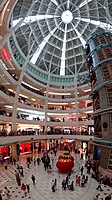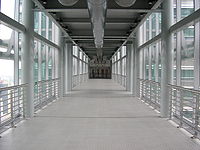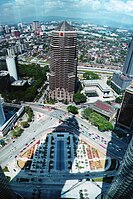
The Kuala Lumpur Tower, colloquially referred to as KL Tower, is a 6-storey, 421-metre-tall telecommunication tower in Kuala Lumpur, Malaysia. It is the world's seventh-tallest tower. It features an antenna which increases its height to 421 metres. The roof of the pod is at 335 metres. The rest of the tower below has a stairwell and an elevator to reach the upper area, which also contains a revolving restaurant, providing diners with a panoramic view of the city.

Suria KLCC is a 6-story shopping mall located at the foot of the Petronas Twin Towers. Suria KLCC is a premier shopping destination with over 300 flagship stores. The shopping mall is situated in Kuala Lumpur City Centre, Kuala Lumpur, Malaysia.

KLCC Property Holdings Berhad is a Malaysian property investment company which owns and manages office, retail and hotel properties in Kuala Lumpur, mainly in the Kuala Lumpur City Centre (KLCC) area. Among the properties owned or managed by the company and its stapled real estate investment trust are the Petronas Twin Towers, Suria KLCC, the Mandarin Oriental Kuala Lumpur and Menara Maxis.
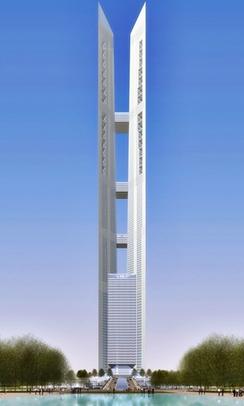
The 151 Incheon Tower was a supertall twin tower proposed for construction in Songdo International City, Incheon, South Korea. The design consisted of two 151 floor, 613 m (2,011 ft) supertall skyscrapers connected by three skybridges. The building would have become the tallest twin towers in the world, surpassing the Petronas Towers in Kuala Lumpur, Malaysia, and one of the tallest buildings in Asia. After the late-2000s recession, the tower was postponed with the possibility of a redesign at a lower height. The height of the tower was reduced from 613 metres to 481 metres while keeping the design the same.

The As Syakirin Mosque, also known as KLCC Mosque, is a mosque located in the Kuala Lumpur City Centre, Kuala Lumpur, Malaysia. The mosque is situated near the Suria KLCC shopping centre and the Petronas Twin Towers, the tallest twin towers in the world.
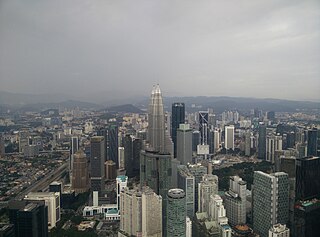
Kuala Lumpur City Centre (KLCC) is a multipurpose development area in Kuala Lumpur, Malaysia. KLCC refers to the area within and surrounding the KLCC Park but the term has also been widely used by buildings nearby to the vicinity.
Jalan Ampang or Ampang Road is a major road in the Klang Valley region, Selangor and the Federal Territory of Kuala Lumpur, Malaysia. Built in the 1880s, it is one of the oldest roads in the Klang Valley. It is a main road to Ampang Jaya and is easily accessible from Jalan Tun Razak or Jalan Ulu Klang from the Hulu Kelang or Setapak direction. It is also accessible from Cheras through Jalan Shamelin, from Jalan Tun Razak through Jalan Kampung Pandan via Taman Cempaka, from Kampung Pandan through Jalan Kampung Pandan Dalam via Taman Nirwana, from the Kuala Lumpur Middle Ring Road 2 via Pandan Indah and Taman Kencana and from Hulu Langat town through the mountain pass. Wangsa Maju, Setapak, central Kuala Lumpur, Ampang Park and Salak South surround Ampang. Jalan Ampang became the backbone of the road system linking Ampang to Kuala Lumpur before being surpassed by the Ampang–Kuala Lumpur Elevated Highway (AKLEH) in 2001.

KLCC LRT station is an underground rapid transit station in Kuala Lumpur, Malaysia, served by the Kelana Jaya Line.

Maxis Tower is a 49-storey, 212 m (696 ft) office skyscraper in Kuala Lumpur City Centre, Kuala Lumpur, Malaysia. The tower serves as headquarters of Maxis Communications and Tanjong Plc Group of Companies.
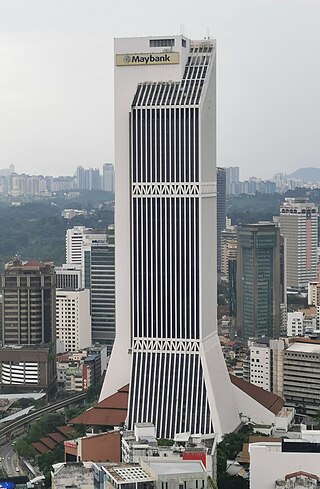
Maybank Tower is a skyscraper in Pudu, Kuala Lumpur, Malaysia. The tower serves as the headquarters of Maybank and houses the Maybank Numismatic Museum.

ExxonMobil Tower formerly known as Menara Esso is a skyscraper located in the Kuala Lumpur City Centre of Kuala Lumpur, Malaysia. The building currently is the headquarters of ExxonMobil Malaysia.

Petronas Tower 3, also known as Carigali Tower, is a 60-story, 267-meter-tall skyscraper in KLCC, Kuala Lumpur, Malaysia. It is Malaysia's eighth tallest building and it is also part of the Petronas Towers complex. The 246-meter high building also features a 21-meter high crown-like structure on the top of the tower, making it 267-meter high. The building features a 6-level extension to the Suria KLCC shopping mall, while the rest of the floors above are solely made up of office spaces. It is the headquarters of Petronas Carigali, the E&P subsidiary of Petronas and some of the local subsidiaries of Multinational Corporations such as Microsoft Malaysia. Along with the Kuala Lumpur Convention Centre and the Binjai On The Park condominiums, the development of Lot C falls under Phase 2 of the KLCC project. Its development cost is reported at RM1 billion.
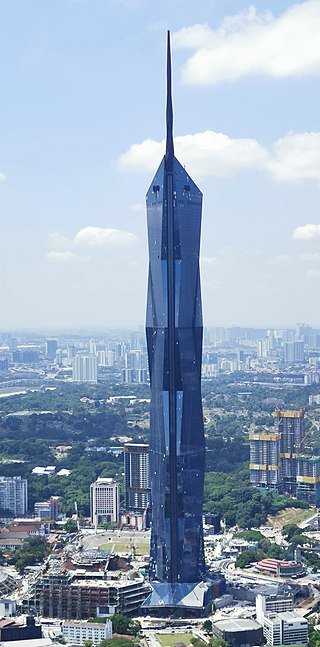
Merdeka 118, formerly known as Menara Warisan Merdeka, KL 118 and PNB 118, is a 118-story megatall skyscraper in Kuala Lumpur, Malaysia. At 678.9 m (2,227 ft) tall, it is the second-tallest building and structure in the world, only behind the Burj Khalifa at 828 m (2,717 ft).

Ilham Tower, also known as Ilham Baru Tower and IB Tower is a 58-storey, 274-metre-tall skyscraper in Kuala Lumpur, Malaysia. It is Malaysia's seventh tallest building. The Ilham Tower is the result of an extensive and careful form-finding process. Its diagonal exo-skeleton, comprising triangulated concrete frames and external trusses, is offset against the elegant glazing within the building's structural armor.

The Exchange 106 (Malay: Menara Exchange 106, formerly known as the TRXSignature Tower, is a 453.6-meter-tall supertall skyscraper in Kuala Lumpur, Malaysia. It is the second-tallest building in Malaysia and the third-tallest building in Southeast Asia. The 397.3-meter building is topped with an 11-story high illuminated crown, giving it a total height of 453.6 m. It is also the second largest skyscraper in Malaysia by floor area with 453,835 m2. The tower has a net lettable area of 240,000 square metres. It is also the centerpiece of the new Tun Razak Exchange financial district.

Four Seasons Place Kuala Lumpur, also known as Four Seasons KLCC and FSP KLCC Tower, is a 74-story, 342.5-metre tall (1,124 ft) supertall skyscraper in Kuala Lumpur City Centre, Malaysia. It features a 21 m (69 ft) high crown made out of steel at the top of the tower, making the tower reaches the height of 342.5 m (1,124 ft). It is located within the Kuala Lumpur City Centre precinct in Kuala Lumpur, Malaysia. The building was developed by Ipoh-born Singapore tycoon, Ong Beng Seng, partnering Tan Sri Syed Yusof Tun Syed Nasir and the Sultan of Selangor under Venus Assets Sdn Bhd. It is currently the sixth tallest building in Malaysia.
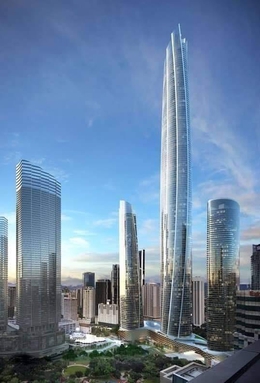
Tower M, formerly known as the KLCC East Gate Tower, is a proposed megatall skyscraper project in Kuala Lumpur, Malaysia situated within the Kuala Lumpur City Centre (KLCC). KLCC Property Holdings Berhad, which was also responsible for the development of the Petronas Twin Towers, is currently developing the building as part of the revised KLCC Development Master Plan 1995. The masterplan was reviewed in 2012 to enhance the development potential of the development's remaining undeveloped parcels.

Permata Sapura Tower is a skyscraper located at the Kuala Lumpur City Centre (KLCC) in Kuala Lumpur, Malaysia. The skyscraper has a height of 252.5 metres with 53 floors. The construction of the skyscraper was completed in 2020 and is currently among the tallest skyscrapers in Malaysia.







